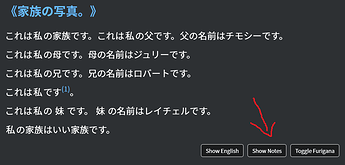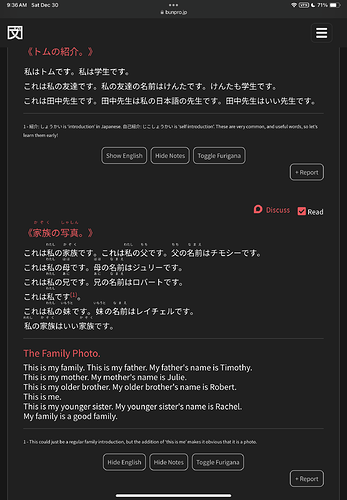This is a discussion topic for the N5 Lesson 1 reading passages.
Why is there an annotation on the sentencem 「これは私です。」Is it something to do with the sentence or just meant for the whole passage.
I don’t know why (これは私です。) is even in the paragraph. Like when I first read it, I thought that it was going to finish introducing the narrator  (これは私です、私の名前は___です。ect.) but guess not. But that is not really important and this website is really useful and dope!
(これは私です、私の名前は___です。ect.) but guess not. But that is not really important and this website is really useful and dope! 
You can always click on the notes button to see eventual additional information (see screenshot)
The これは私です。is to make it clear that this is describing a picture, because you wouldn’t use “これは私です” to start your self-introduction.
yo i didn’t even see that thanks 
これは私の友達です。
Is this correct? I was taught to only use これ・それ・あれ with inanimate objects, and to use この人・こちら・この方 with people (for politeness reasons).
In the reading 《家族の写真。》using これ makes sense because the speaker is talking about a picture.
I never even knew there was a reading area!!
The usage you’re describing is correct! Although you can use これ too, so I wouldn’t say that you can only use it that way.
Using これ in this context gives the meaning of “This here is my friend”, being more casual than rude.
A way to scale this would be to call someone “こいつ”, although this is more rude hands down.
Hope this helped!
田中 do be teaching good though
I really enjoyed the reading! I feel the reading helps a lot more after having learned the material because you see a sentence structure cohesively. rather than trying to figure out what’s missing during the study sessions
I enjoyed reading this one without checking the English translation i could understand
Seems like conversation regarding this reading passage has died down, so in the spirit of Christmas, time to resurrect it! 
First of all, just want to say that these readings are really helpful and encouraging to new learners, so thank you to the Bunpro team.
Secondly, I’d like some pronunciation/diction guidance from Japanese natives, those living in Japan, or those with regular conversations in Japanese at a higher level. While I appreciate those with less experience, and acknowledge that even a low-intermediate has something to teach a brand new beginner like me, I also have already seen that there can be some confidently-stated mistakes, especially in the pronunciation realm and so I would ask newer speakers like myself to refrain from constructive critique for the sake of effeciency. The Dunning-Kruger effect is real, I suffer from it too. 
Here is my reading of N5 L1. I really struggle with all things pronunciation, so please feel free to give a comprehensive and constructive critique. Vocaroo | Online voice recorder
ありがとございます!
The furigana spacing is weird on my iPad Air — not really sure where to report this. Anybody know?
The furigana is closer to the line above than the line that ti’s about — very confusing.
I felt better for doing these reading sections. it helps immensely to restructure what i learn about in the grammar decks. Thank you!
I had to look up most of the words with kanji in Jisho, but I made it through all three readings! That was so rewarding!
What really surprised me is how much you’re able to say and understand with just a handful of grammar points. Sometimes the 3 points/day limit feels too low, and even 12 or 15 grammar points feels like nothing at all. The reading made me see just how much you can convey with simple grammar.


